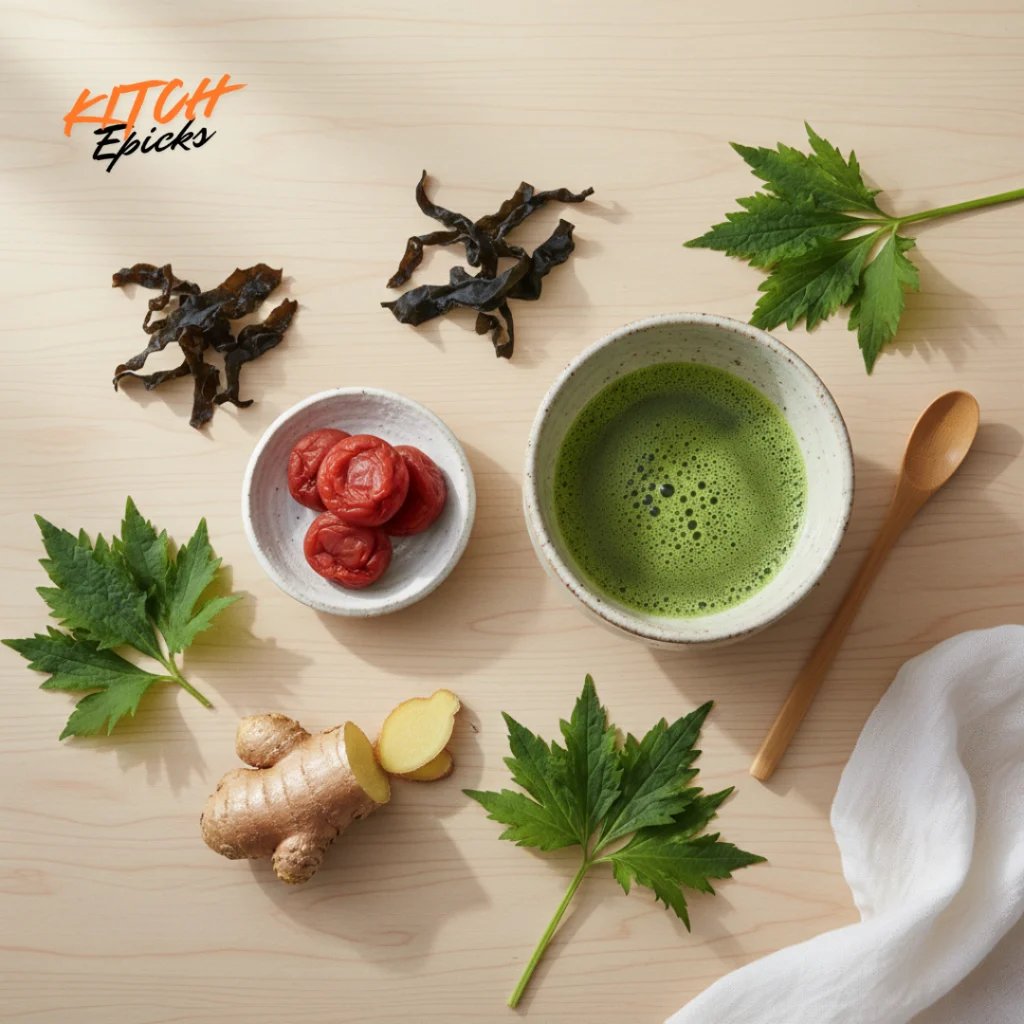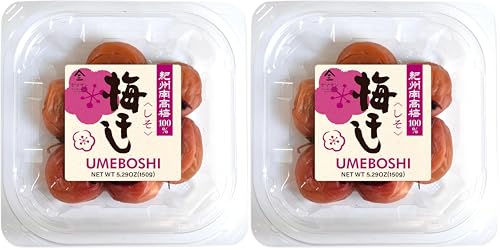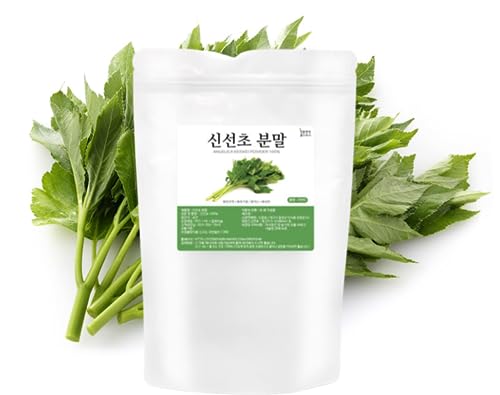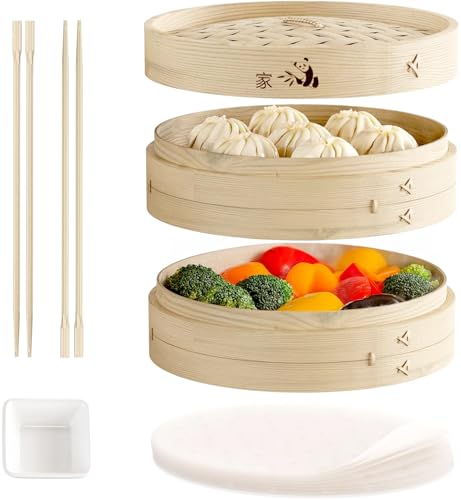The Viral Sensation Meets Medical Reality
The “Japanese Mounjaro recipe” has exploded across TikTok and Instagram, racking up millions of views as users search for natural weight loss solutions. Videos promise dramatic results with mysterious “ancient Japanese drinks” that supposedly work like the prescription medication Mounjaro. Before you blend up that matcha detox or order supplements from dubious ads, you need to understand what’s actually happening here.
Let’s be absolutely clear: The viral drinks circulating online are not the same as prescription Mounjaro (tirzepatide) and are not clinically proven alternatives. Mounjaro is an FDA-approved injectable medication that mimics GLP-1 hormones to regulate blood sugar and appetite in Type 2 diabetes patients. It’s a pharmaceutical intervention that requires medical supervision—not something you can replicate with tea leaves and pickled plums.
This comprehensive guide will dissect the popular drink recipes making waves online, expose the supplement scams piggybacking on this trend, and introduce you to the Japan Diet—an evidence-based eating approach recommended by the Japan Atherosclerosis Society for preventing atherosclerotic cardiovascular disease (ASCVD). Unlike trendy detox drinks, this is backed by actual medical authorities.
This guide was developed with input from professionals experienced in clinical nutrition, metabolic health, and Japanese dietary research. The content draws on peer-reviewed data and official recommendations from trusted sources such as the Japan Atherosclerosis Society, the World Health Organization (WHO), and the American Heart Association (AHA). It reflects practical experience in applying evidence-based nutrition principles to real-world settings—bridging traditional Japanese eating patterns with modern, medically supported dietary strategies for long-term health.
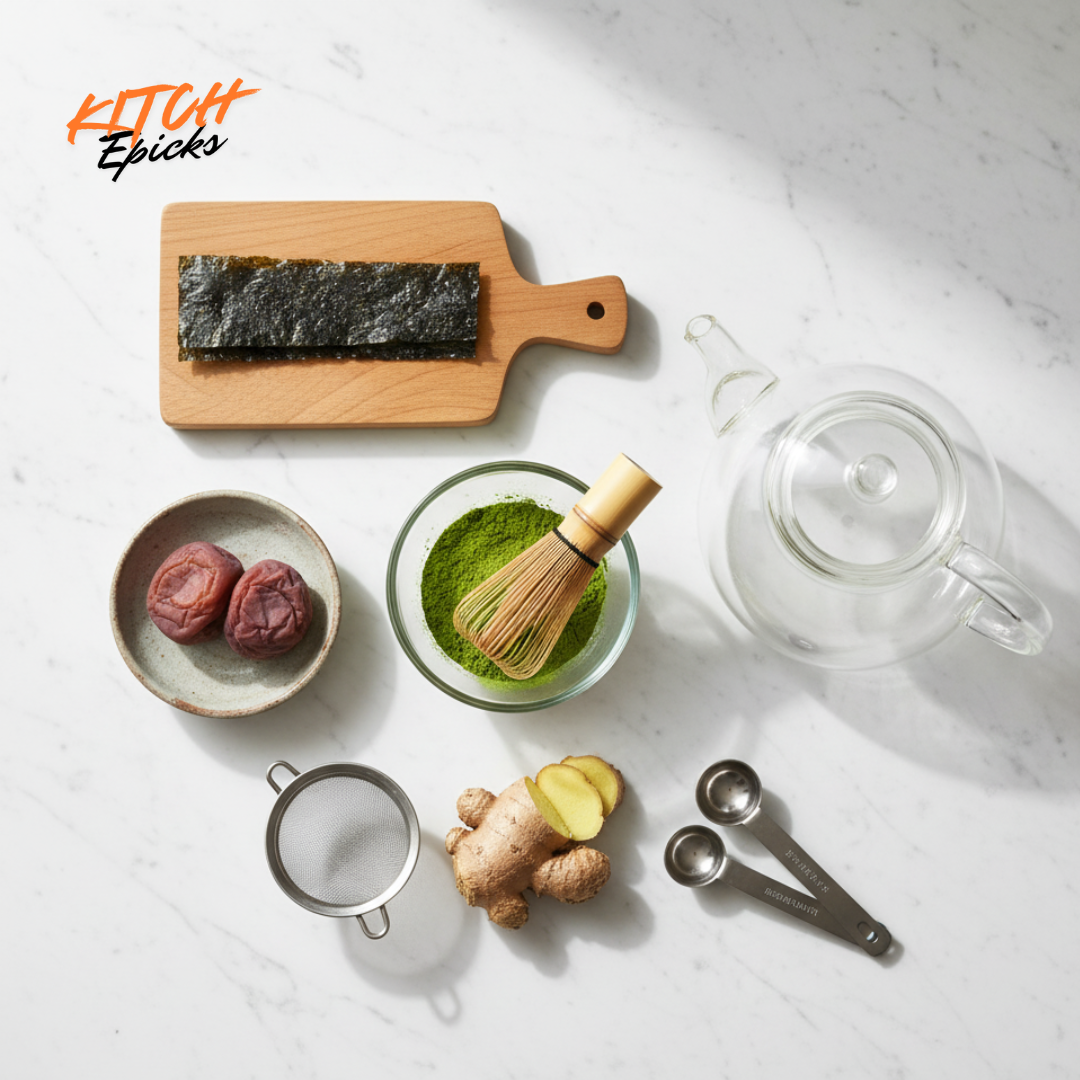
Debunking the Hype: The “Natural Mounjaro” Trend (Scams & Ingredients)
The Japanese Mounjaro SCAM: How Marketers Exploit Your Hope
Here’s how the scam works: You watch an emotionally charged video testimonial about someone losing 10-17 pounds in days. The video mentions a “Japanese Mounjaro recipe” but never actually shares it. Instead, you’re directed to purchase unregulated supplements like Honey Burn or Gonodto—products with zero scientific validation and questionable ingredient lists.
Red flags to watch for:
- Unrealistic weight loss claims (losing double-digit pounds in days)
- “Fat in your stool” testimonials designed to shock
- Video sales letters (VSLs) that manipulate emotions but provide no recipe
- Clickbait articles that promise the recipe but redirect to supplement sales pages
- No transparency about actual ingredients or preparation methods
These marketers are capitalizing on legitimate interest in GLP-1 mimicking compounds found in certain Japanese herbs, but they’re selling you expensive pills instead of sharing actual recipes or dietary guidance.
The Two Popular “Natural Mounjaro” Recipes
Despite the scams, two distinct homemade Japanese mounjaro recipes have gained traction among health enthusiasts researching how to make Japanese mounjaro drinks at home.
Recipe A: The Matcha & Umeboshi Detox Drink
Step 1: Ingredients
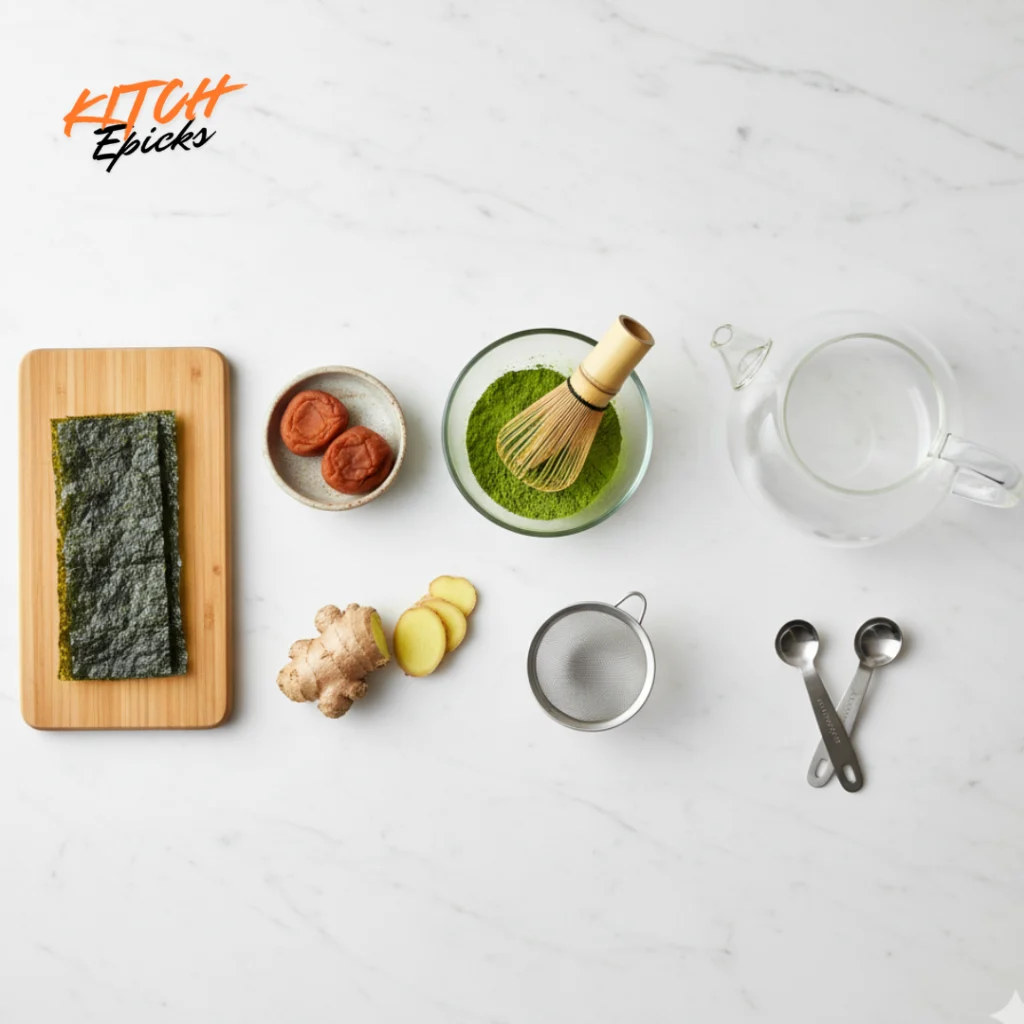
Step 2: Kombu Steeping
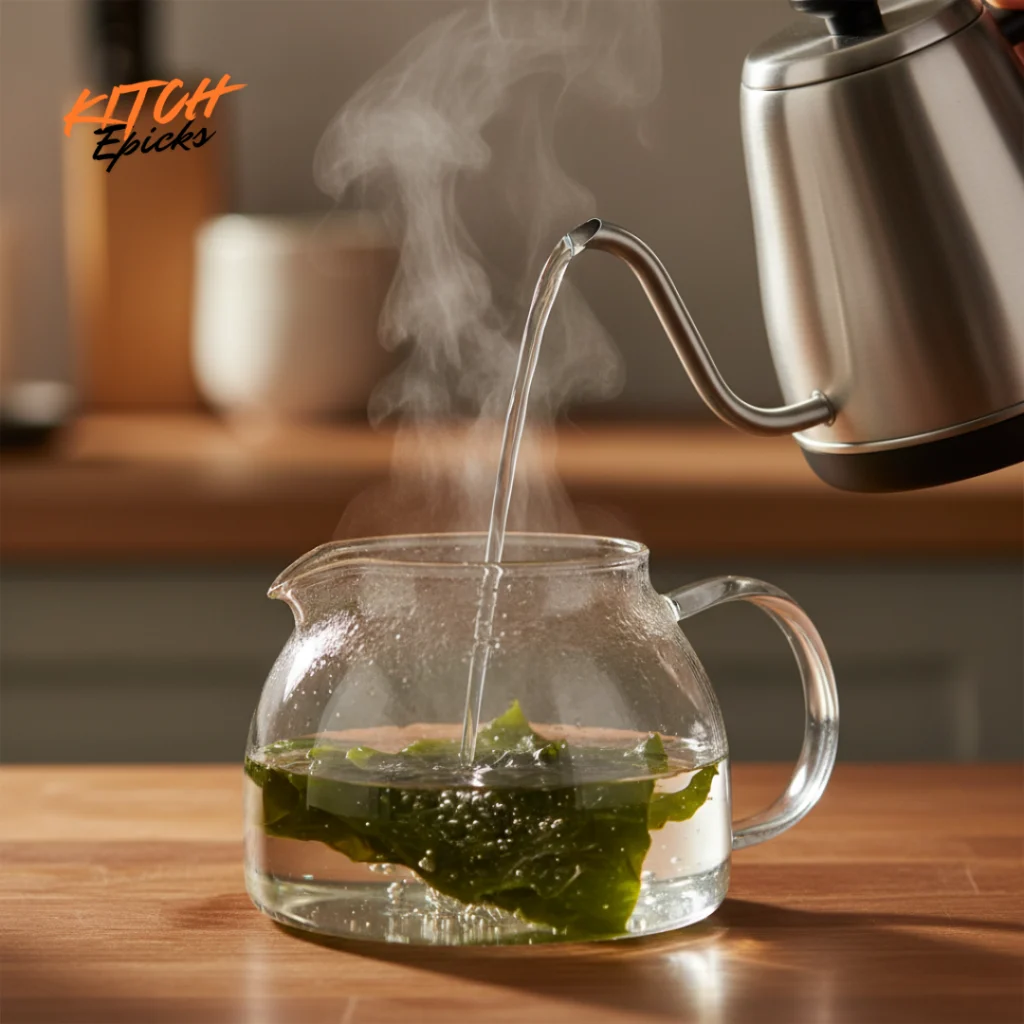
Step 3: Whisking Matcha
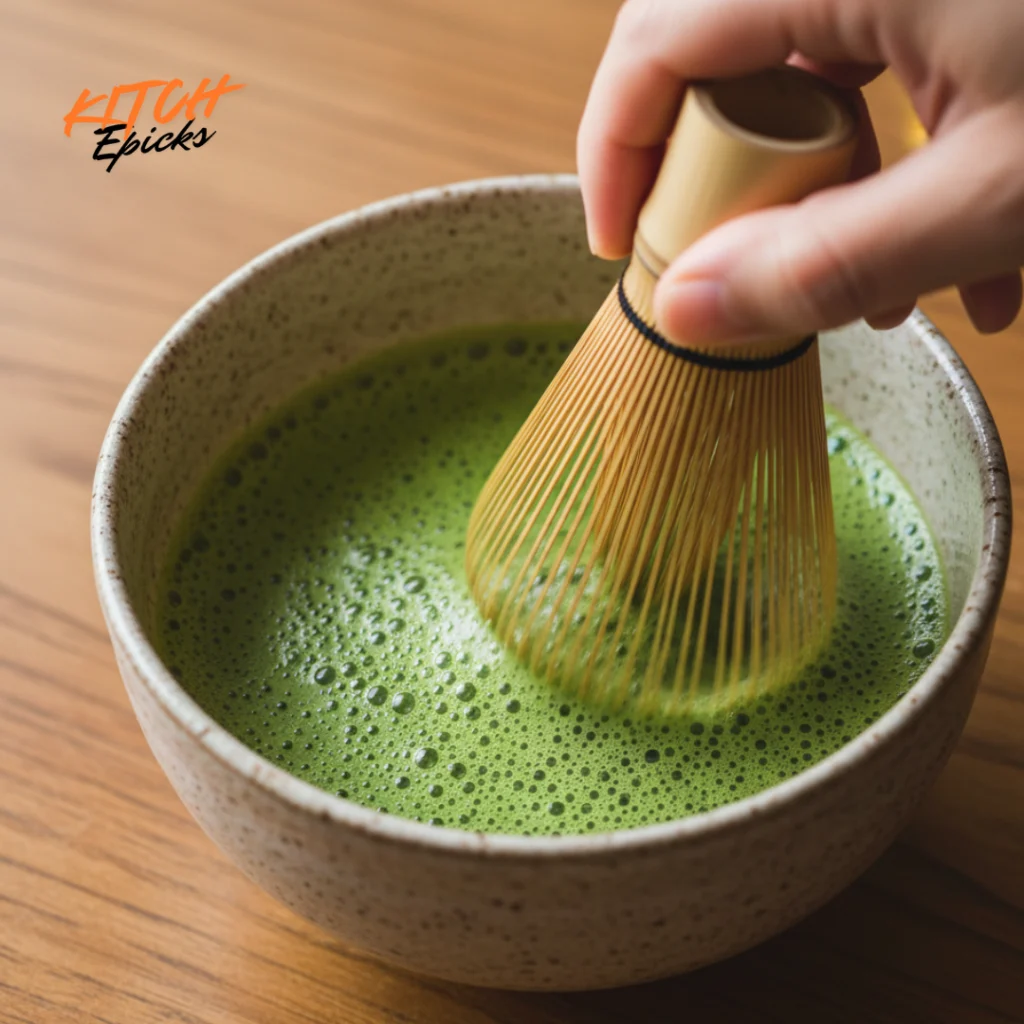
Step 4: Combining
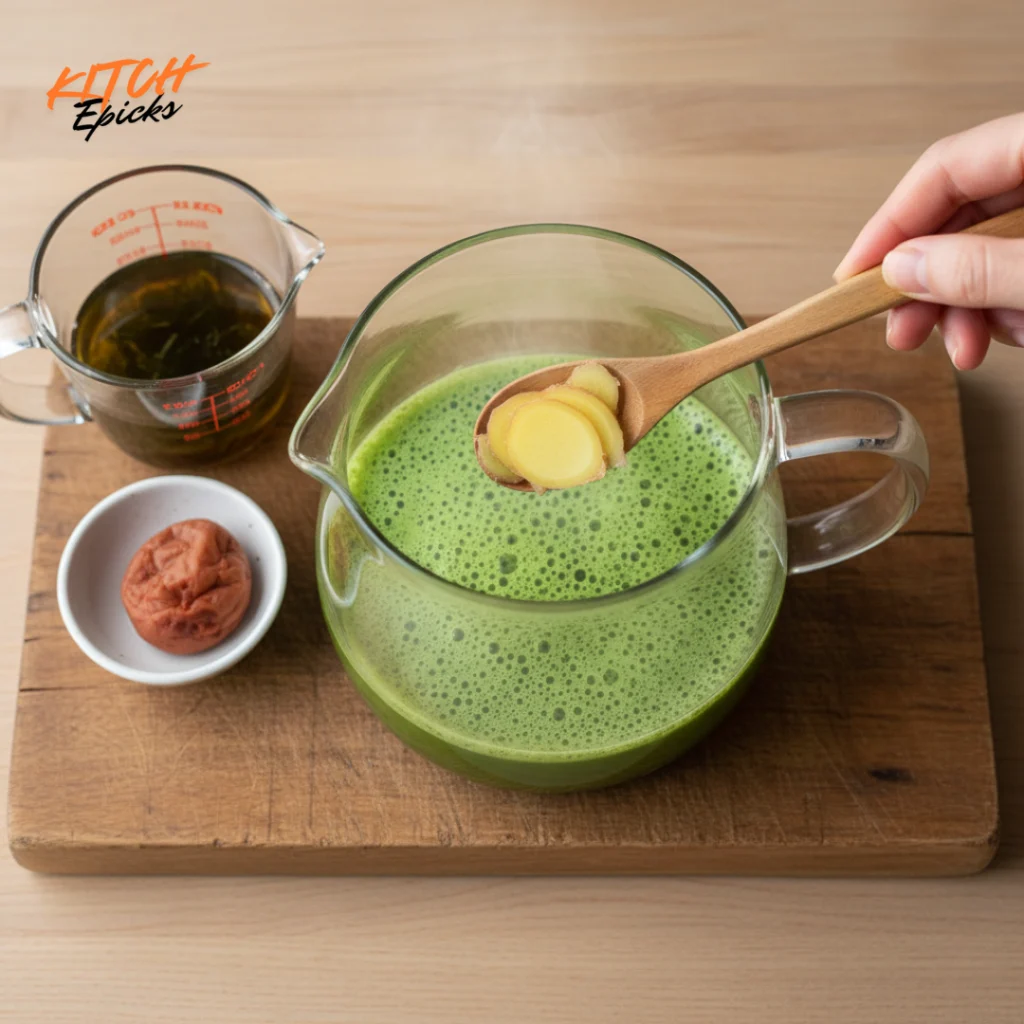
Step 5: Final Presentation
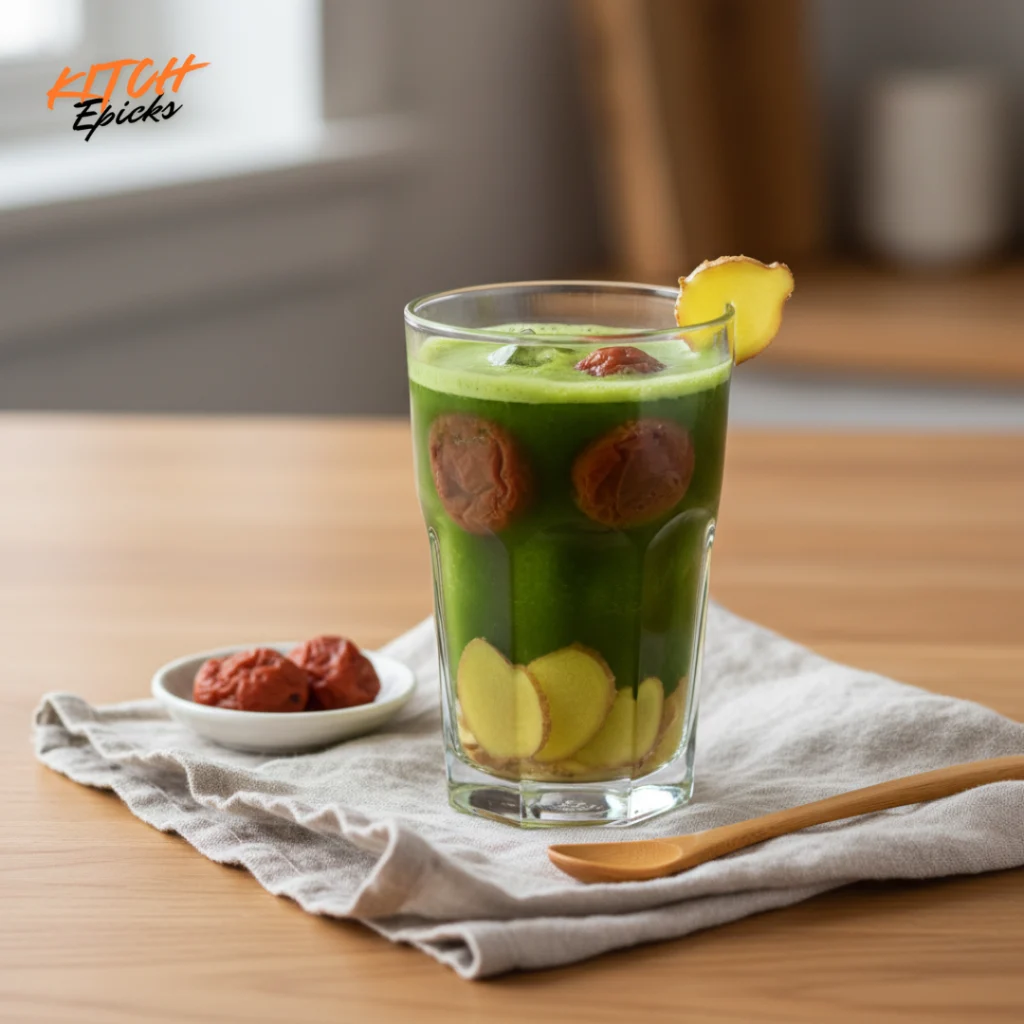
This easy Japanese mounjaro recipe combines traditional ingredients known for digestive support:
Core ingredients: Matcha green tea powder, kombu (dried kelp), umeboshi (pickled Japanese plum), and fresh ginger
- Flavor Profile: Grassy, vibrant, crisp and vegetal
- Double Teas: Experience our intensely delicious Double Teas! Your kettle will love these tea bags – filled with organic …
- Steeping Instructions: Steeping green tea is easy. Simply heat fresh, filtered water just short of boiling. Then pour 6 …
Claimed benefits: The matcha provides catechins and antioxidants, kombu offers natural iodine and minerals, umeboshi adds probiotics and digestive enzymes, while ginger provides anti-inflammatory compounds and warmth.
Critical caution: Kombu contains significant iodine levels that can interfere with thyroid function when consumed regularly. Umeboshi is high in sodium. If you have thyroid conditions, high blood pressure, or kidney issues, consult your doctor before consuming this drink regularly. This is not suitable for daily consumption without medical guidance.
- The information below is per-pack only
- ✅Not only using the premier brand “Kishu Nanko-ume” 100%, but also using only the top grade(Grade A) of all Kishu Nanko-…
- ✅Dried plums are a common pickle in Japan that goes well with white rice. Dried plums in Japan, come in a variety of sha…
Recipe B: The Herbal GLP-1 Alternative
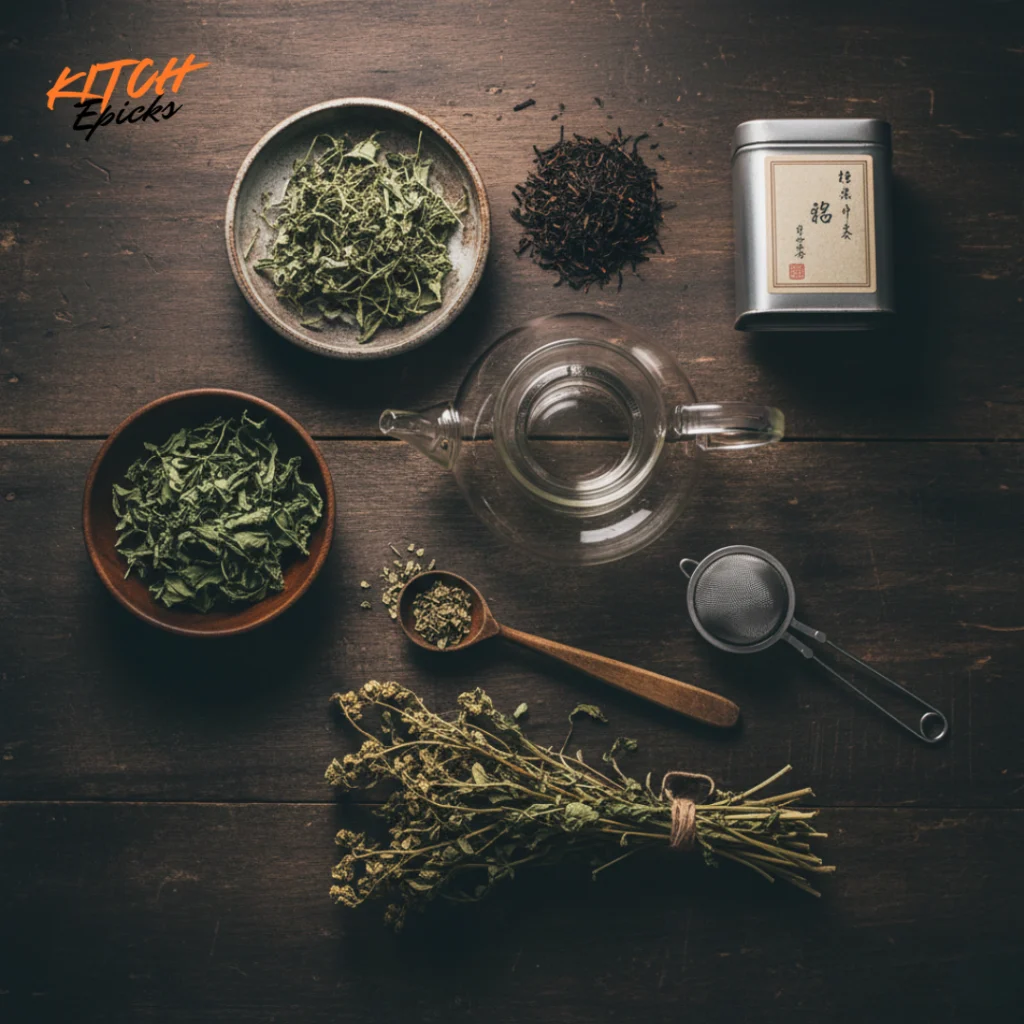
Steeping Herbs
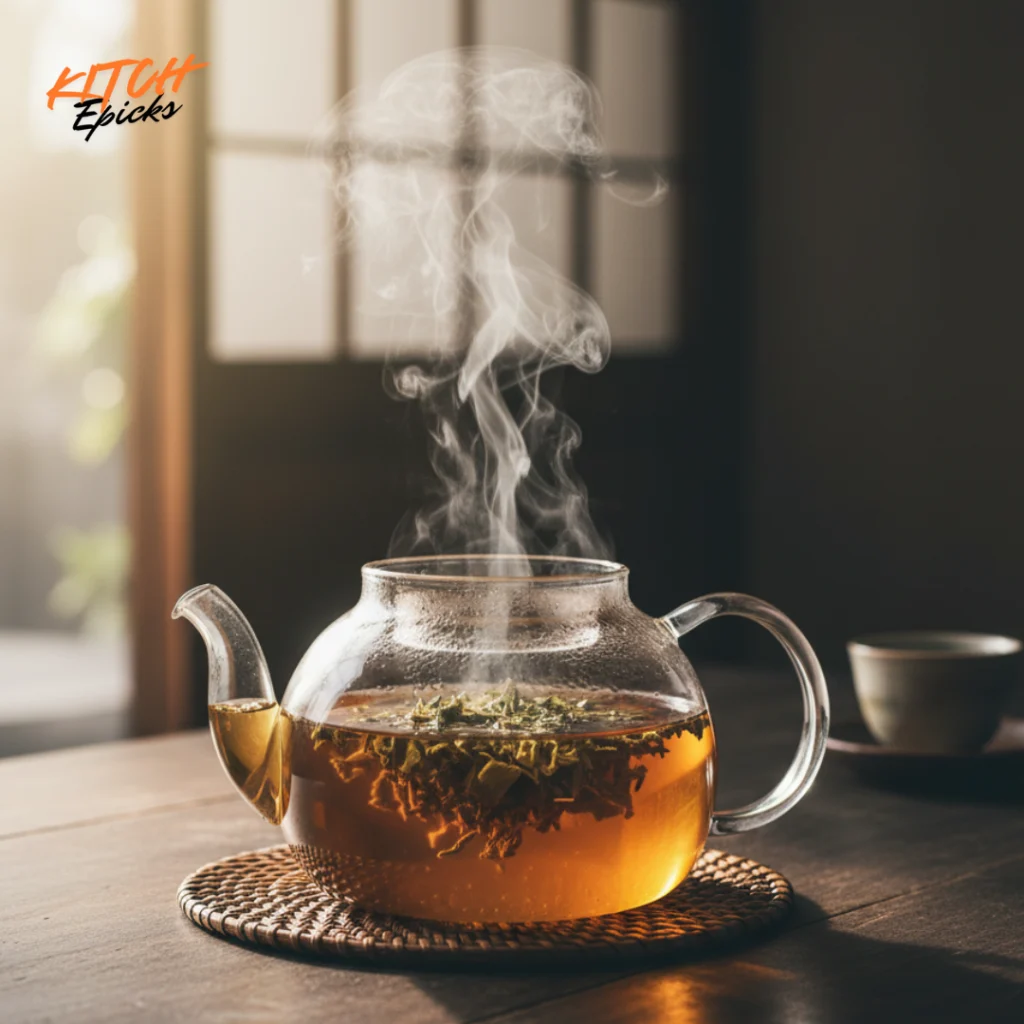
Straining Tea
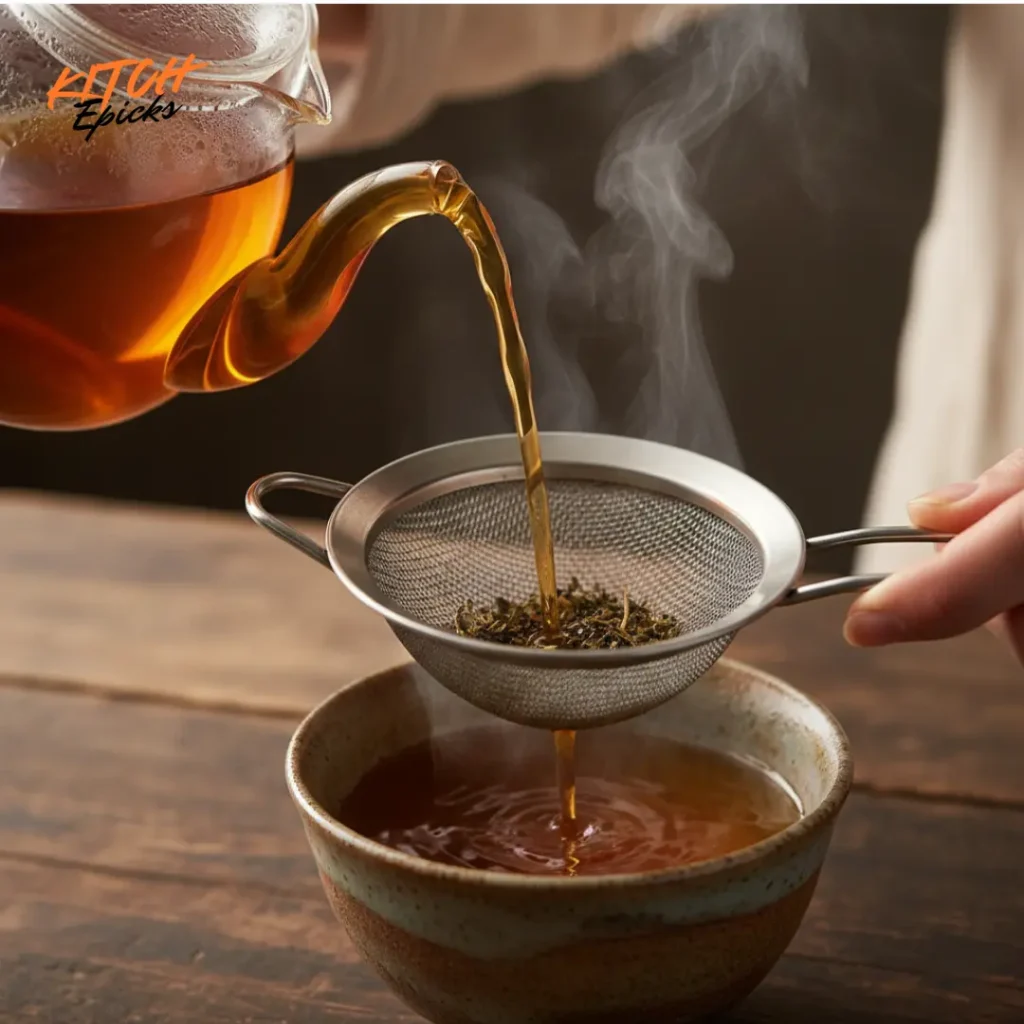
Final Herbal Tea
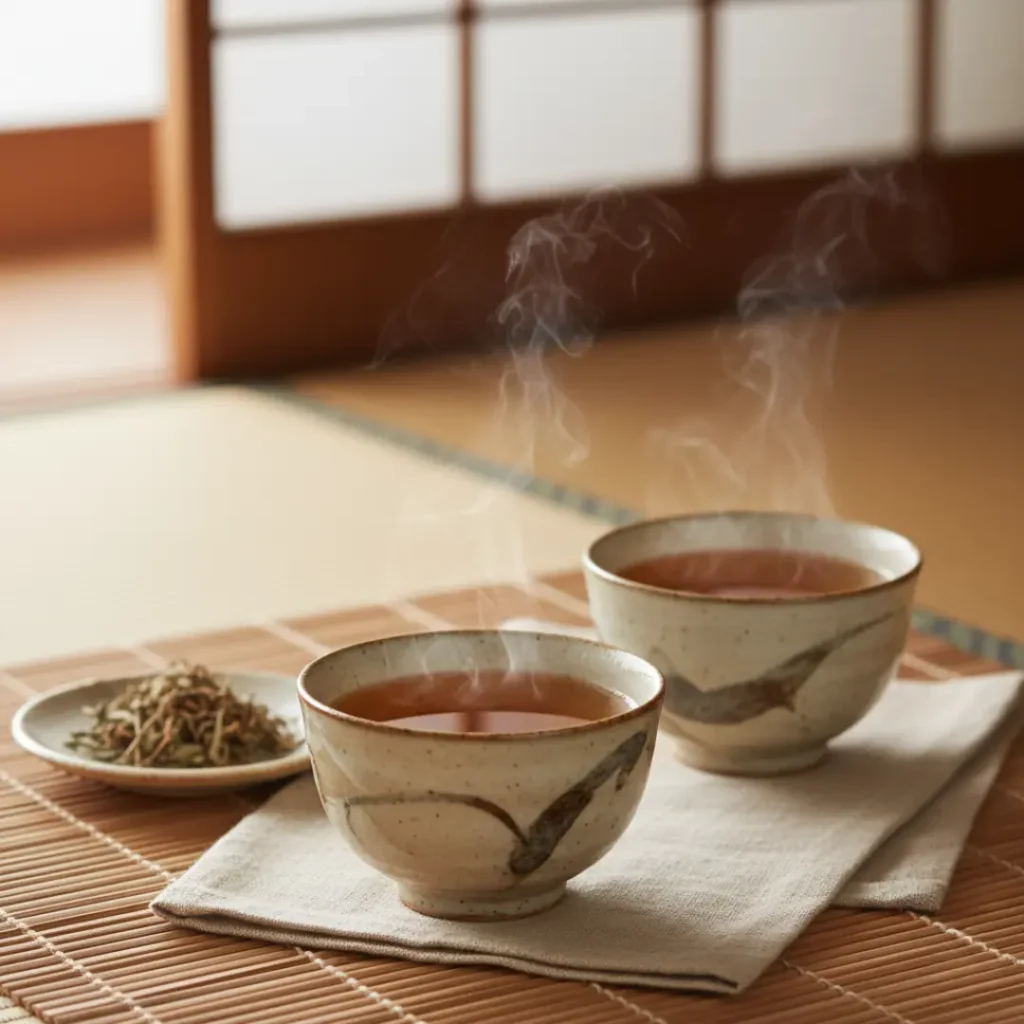
This best Japanese mounjaro recipe variation focuses on herbs believed to influence metabolic pathways:
Core ingredients: Ashitaba, yomogi (Japanese mugwort), dokudami (chameleon plant), and pu-erh tea
Proposed mechanism: Ashitaba contains chalcones—bioactive compounds that preliminary research suggests may enhance insulin sensitivity and encourage fat oxidation. Yomogi provides chlorophyll and bitter compounds that may support liver function. These herbs theoretically support some metabolic pathways similar to GLP-1 agonists, but the effect is indirect, mild, and not a pharmaceutical replacement.
These homemade Japanese mounjaro drinks may offer some general wellness benefits from their antioxidant and digestive support properties, but they are not weight loss medications.
The Authentic “Japan Diet”: A Medically Approved Eating Style
Want to know what Japanese health authorities actually recommend? The Japan Atherosclerosis Society has developed “The Japan Diet” specifically for preventing atherosclerotic cardiovascular disease—a leading cause of death worldwide.
This is not Washoku (traditional Japanese cuisine), which can be extremely high in sodium from soy sauce, miso, and pickled foods. The Japan Diet is a modern, evidence-based eating framework that emphasizes nutritional balance and light seasoning. You can follow this approach using Japanese ingredients or adapt it to your local cuisine.
Important qualification: This dietary guidance is designed for adults under 65 years old. Those 65 or older have different nutritional needs and should consult their physician for personalized recommendations, as older adults require careful attention to protein intake and calorie sufficiency.
The Japan Diet focuses on consuming a variety of dishes with optimal nutritional balance while dramatically reducing salt intake—addressing the primary dietary risk factor for cardiovascular disease in Asian populations. Using smart kitchen tools for healthier cooking can make following this dietary approach significantly easier.
Structuring Your Meals: The Japan Diet Blueprint
The Basic Combination: Visual Balance on Your Plate
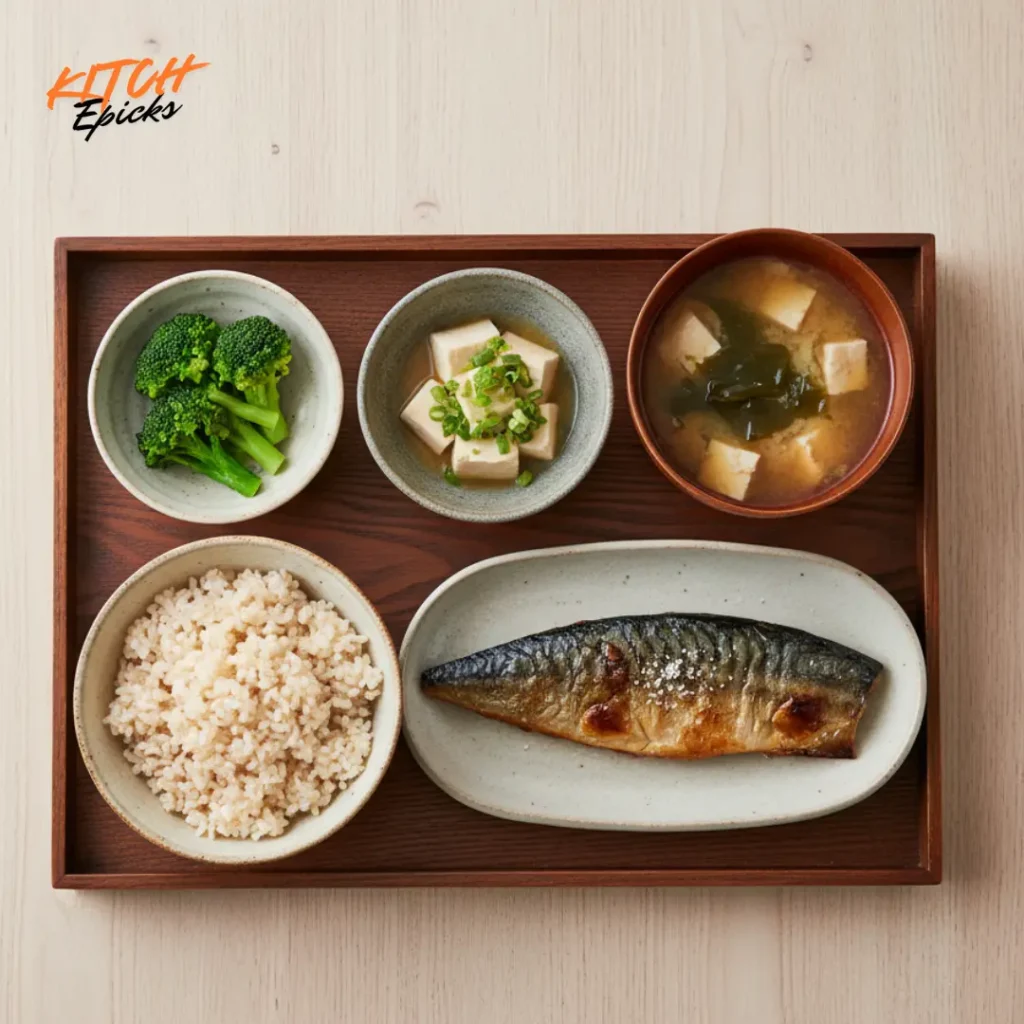
Every meal should include: one staple food + one main dish + two side dishes + soup
This structure ensures you’re getting carbohydrates, protein, fiber, vitamins, and minerals at every eating occasion. Think of it as building blocks rather than restrictive rules.
Staple Food: Choosing Smarter Carbohydrates
Recommended: Unrefined grains and millet—brown rice, barley rice, rye bread, whole wheat bread, buckwheat noodles (soba)
- Ready-to-heat brown and wild rice blend
- 8.8 ounce microwaveable pouch
- Cooks in 90 seconds
Why it matters: These complex carbohydrates contain fiber that slows glucose absorption, providing steady energy and better satiety compared to refined grains.
Target portion: Aim for carbohydrates to comprise approximately one-third of your daily caloric intake. For a 1,800-calorie diet, that’s roughly 600 calories from quality carbs.
Main Dish: Protein That Protects Your Heart
Prioritize: Fish (especially fatty fish like salmon, mackerel, sardines), soybeans and soy products (natto, tofu, edamame), lean meats, and eggs
Preparation methods: Raw (sashimi), steamed, grilled, boiled, or lightly sautéed with minimal oil
Avoid: Fatty cuts of meat, marbled beef, ground meat with high fat content, chicken skin, and excessive egg consumption (particularly egg yolks if you have elevated cholesterol)
The emphasis on fish and soy provides omega-3 fatty acids and plant-based protein that support cardiovascular health—a key distinction from Western dietary patterns heavy in red meat. When preparing lean proteins, choosing between a skillet vs frying pan can impact how much oil you need for cooking.
[AFFILIATE LINK SPACE: High-quality fish oil supplements or omega-3 rich foods]
For grilling fish perfectly without excess oil, the best air fryer 2025 models offer precise temperature control that preserves nutrients while achieving crispy exteriors. Many health-conscious cooks are discovering that air fryers excel at preparing Japanese-style grilled fish with minimal added fats.
Side Dish: The Fiber and Micronutrient Foundation
Recommended: Green and yellow vegetables, cruciferous vegetables, seaweed (wakame, nori, kombu), mushrooms (shiitake, enoki, maitake), and konjac
Daily target: At least five servings of vegetables plus one serving of seaweed, mushrooms, or konjac. Practically, this means two small bowls of vegetables at each of your three meals.
Cooking methods: Raw salads, steaming, light dressing (use sparingly), boiling, baking, or quick sautéing
These foods provide fiber for digestive health, antioxidants for cellular protection, and minerals like potassium that help balance sodium intake—all while being extremely low in calories. If you’re meal prepping for work, storing these vegetable dishes in the best electric lunch box 2025 models helps maintain food quality and temperature.
- Time-tested method for creating restaurant-style dishes at home, including dumplings, veggies, and fish
- Two tiers to cook several dishes or servings at a time
- So simple to use: place in a pan of water and heat
Soup & Extras: Completing the Nutritional Picture
Soup serves as an excellent vehicle for incorporating more soybeans, vegetables, seaweed, and mushrooms. A miso soup with tofu, wakame, and mushrooms checks multiple nutritional boxes in one bowl.
- MISO SOUP MIX – This all-natural freeze-dried soup mix boasts full-bodied flavor. Traditional miso soups are made with a…
- VEGETARIAN GOODNESS – Miso-Cup boasts a rich, satisfying flavor that is great as the foundation for soup, or stews. Sinc…
- SUSTAINABLY FARMED – We support organic & sustainable farming that avoids GMOs & pesticides. We’re proud participants in…
For snacks or dessert, choose fruits with lower sugar content (berries, citrus) and moderate amounts of dairy products like unsweetened yogurt.
Maximizing Results: Foods to Eat and Foods to Avoid
| Foods to Emphasize (Eat Abundantly) | Foods to Limit or Avoid |
|---|---|
| Fish, especially fatty varieties (salmon, mackerel, sardines) | Fatty meats (marbled beef, ground meat, chicken skin) |
| Soybeans and soy products (natto, tofu, tempeh) | Animal fats (beef tallow, lard, butter), coconut oil |
| Unrefined grains (brown rice, barley, rye bread, whole wheat) | Egg yolks (if cholesterol is elevated) |
| Green and yellow vegetables (spinach, carrots, peppers) | Processed meats (bacon, fatty ham, sausages) |
| Seaweed, mushrooms, and konjac | Sugar-sweetened beverages and processed snacks |
| Low-sugar fruits (berries, citrus) | Alcoholic beverages |
| Refined grains (white rice, white bread) |
This table provides a clear roadmap for grocery shopping and meal planning based on cardiovascular disease prevention research.
- Susanna and Adam created their unique Tofu Press to press tofu evenly and cleanly to give you perfect, very firm, crack-…
- Our Unique Tofu Press presses tofu evenly and cleanly to give you perfect, very firm, crack-free tofu every time with no…
- Our patented, simple to use press has only 3 parts and allows for mess-free pressing with no need for paper towels. Your…
Advanced Optimization: Fat, Salt, and Caloric Balance
Reducing Salt for Cardiovascular Health
High sodium intake elevates blood pressure and increases cardiovascular disease risk—a particularly significant concern given that traditional Japanese cuisine can contain 10-15 grams of sodium daily. The Centers for Disease Control and Prevention (CDC) recommends limiting sodium to less than 2,300 mg per day for most adults.
Practical strategies:
- Use dashi (kelp and bonito broth) to add umami depth without salt
- Incorporate aromatic vegetables and spices like ginger, garlic, lemon, and shiso
- Add vinegar or citrus to enhance flavor perception
- Don’t drink the broth from noodle dishes
- Reduce pickled foods and salted condiments
Managing Fats and Oils: Quality Over Quantity
All fats provide 9 calories per gram, but their impact on health varies dramatically.
Prioritize: Vegetable oils rich in unsaturated fats (olive oil, canola oil, sesame oil) if your LDL cholesterol is elevated
Minimize: Saturated fats from animal sources (lard, beef tallow, butter) and tropical oils (coconut oil)
Maximum saturated fat intake by daily calorie level:
- 1,600 kcal diet: Maximum 12g saturated fat
- 1,800 kcal diet: Maximum 14g saturated fat
- 2,000 kcal diet: Maximum 16g saturated fat
- 2,200 kcal diet: Maximum 17g saturated fat
To put this in perspective, one tablespoon of butter contains 7 grams of saturated fat—nearly half your daily limit on a 1,600-calorie plan.
[AFFILIATE LINK SPACE: Cold-pressed sesame oil or extra virgin olive oil]
Modern cooking appliances have revolutionized low-fat cooking methods. The Ninja air fryer review 2025 highlights how this appliance can prepare traditional Japanese dishes like grilled fish and vegetables using up to 75% less oil than conventional frying methods.
Importance of Personalized Calorie Guidance
The appropriate caloric intake must be determined based on your height, weight, activity level, and any existing health conditions. This requires consultation with a doctor or registered dietitian who can assess your individual needs. The National Institutes of Health (NIH) provides comprehensive resources for understanding individual nutritional requirements.
Sample 1,600-calorie day structure:
Breakfast: Two slices rye bread, sautéed chicken breast with vegetables, fruit with plain yogurt
Lunch: Buckwheat soba noodles with natto, side of steamed greens
Dinner: 150g cooked brown rice, grilled mackerel, simmered vegetables with tofu
This example demonstrates balanced macronutrient distribution across meals while emphasizing whole foods and moderate portions. For breakfast variety that aligns with portion control, check out hash brown patties in the air fryer for a healthier take on morning carbohydrates.
- 𝗘𝗳𝗳𝗼𝗿𝘁𝗹𝗲𝘀𝘀 𝗪𝗲𝗶𝗴𝗵𝗶𝗻𝗴: Supports 5 units (oz/lb:oz/fl’oz/g/mL), tare function, and includes 2 AAA batteries for hassle-free…
- 𝗣𝗿𝗲𝗰𝗶𝘀𝗲 𝗥𝗲𝘀𝘂𝗹𝘁𝘀: Accurately weighs up to 11 lb/5 kg with 1 g increments
- 𝗦𝗶𝗺𝗽𝗹𝗲 & 𝗖𝗼𝗺𝗽𝗮𝗰𝘁: The small and sleek scale is a perfect fit for most kitchens, occupying little space and easily storab…
Practical Kitchen Tools for the Japan Diet
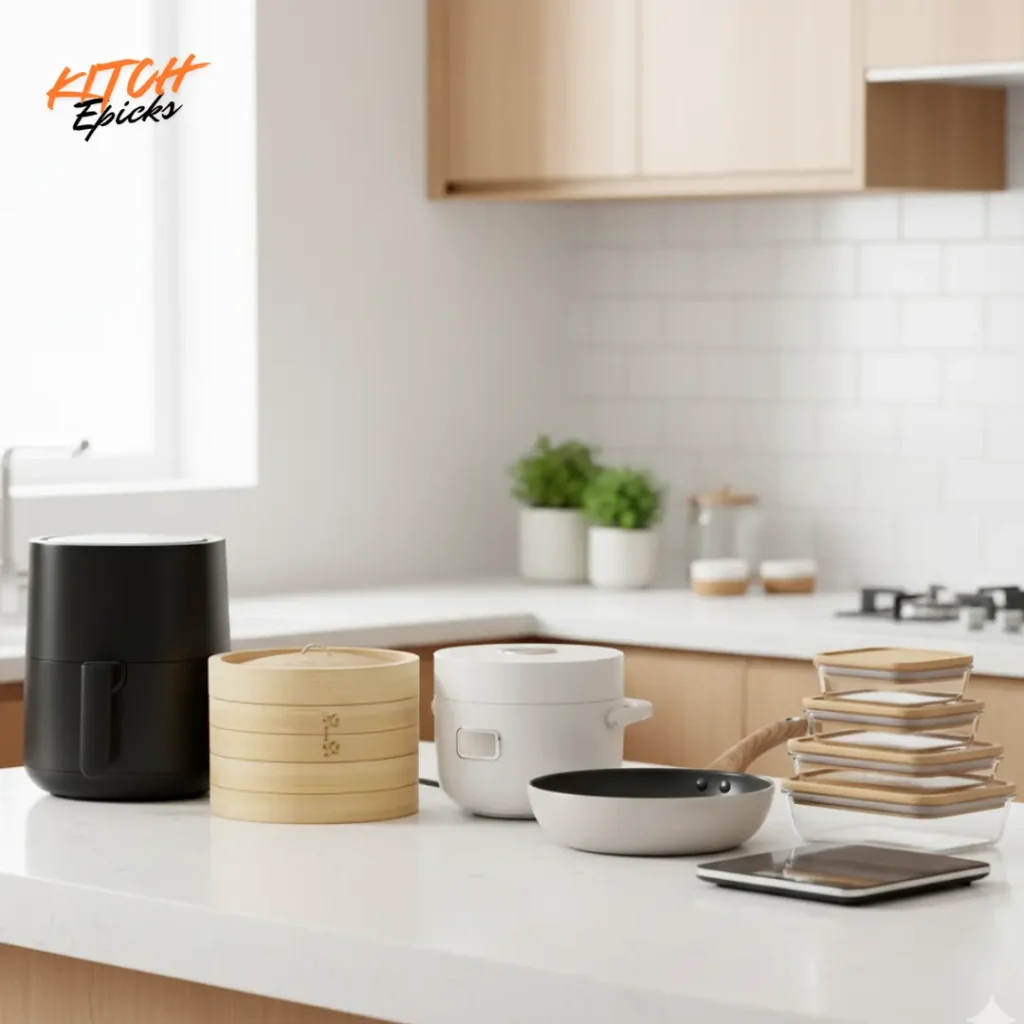
Implementing the Japan Diet becomes significantly easier with the right kitchen equipment. Smart kitchen tools for healthier cooking can streamline meal preparation while reducing the need for excess oils and fats.
Essential tools for Japan Diet cooking:
- Easy-to-use programmable digital controls complete with an automatic Keep Warm mode after each cycle
- An array of preset functions for every kind of meal: White Rice, Brown Rice, Steam, Flash Rice
- Steam meat, vegetables and more with the provided Steam Tray all while rice cooks below
A quality rice cooker with a brown rice setting ensures perfectly cooked unrefined grains every time. Unlike white rice, brown rice requires longer cooking times and precise water ratios—features that modern rice cookers handle automatically.
- Elevate Your Culinary Game! The Prime Home Direct 10″ Bamboo Steamer Basket Set is your must-have kitchen companion! Mad…
- Double the Flavor, Double the Fun! Our cutting-edge 2-tier design takes steaming to the next level, letting you cook mul…
- Steam Like a Pro! Our 10″ bamboo food steamer boasts water-resistant walls and a dome-shaped lid, keeping condensation a…
Steaming is a cornerstone cooking method in the Japan Diet. A bamboo steamer preserves nutrients in vegetables, fish, and dumplings without adding any fat.
For those seeking versatile cooking appliances, exploring the best air fryer 2025 reviews 10 top-rated models reveals options that excel at grilling, steaming, and roasting—all Japan Diet-approved cooking methods. These appliances can prepare everything from grilled mackerel to roasted vegetables with minimal oil.
- Benriner Mandolin Slicer
- Adjustable blade makes slices of varying thickness; Ranging from fine to medium
- Also with the coarse replaceable blades the Benriner is capable of cutting slices of three different sizes
Even breakfast items can be adapted to Japan Diet principles. While traditional best home waffle makers typically produce sweet treats, whole grain waffles with moderate toppings can fit within the diet’s framework when portion-controlled and paired with protein-rich accompaniments.
Choosing the Right Path to Wellness
The “Japanese Mounjaro recipe” phenomenon reveals our collective desire for simple solutions to complex health challenges. While the viral drinks contain traditional ingredients with some beneficial properties, they are not miracle cures or pharmaceutical replacements—and the supplement scams surrounding them prey on desperation.
The Japan Diet offers something more valuable: a structured, evidence-based approach to eating that has been refined by medical experts specifically to prevent cardiovascular disease. It emphasizes whole foods, balanced macronutrients, abundant vegetables, quality protein sources, and dramatic sodium reduction.
Your sustainable path forward involves prioritizing protein and fiber at every meal, controlling total caloric intake based on your individual needs, reducing saturated fats and sodium, and consulting healthcare professionals for personalized guidance. These fundamentals—not trendy detox drinks—form the foundation of lasting health improvements.
The right kitchen equipment makes adherence easier and more enjoyable. Whether you’re investing in the best air fryer 2025 reviews show the top performers, or simply upgrading your steaming and grilling tools, these investments in your cooking infrastructure pay dividends in long-term health outcomes.
Frequently Asked Questions (FAQs)
Is the Japanese Mounjaro recipe the same as the Mounjaro drug?
No. Mounjaro (tirzepatide) is an FDA-approved prescription medication that requires medical supervision. The “Japanese Mounjaro recipe” refers to wellness drinks made from traditional Japanese ingredients like matcha, herbs, and fermented foods. These drinks are not pharmaceutical products and cannot replicate the specific mechanisms of the prescription drug. According to the U.S. Food and Drug Administration (FDA), only prescription GLP-1 agonists have been clinically proven to provide specific metabolic benefits for Type 2 diabetes and weight management.
Are there Japanese herbs that mimic Mounjaro’s effects?
Herbs like ashitaba and yomogi contain bioactive compounds called chalcones that preliminary research suggests may support insulin sensitivity and metabolic function through pathways that overlap somewhat with GLP-1 agonists. However, this effect is indirect, moderate, and not comparable to prescription medications. These herbs may support general metabolic health but should not be viewed as drug alternatives.
- Natural Ingredients: We only choose the fresh mugwort leaves as raw materials without adding artificial flavor or additi…
- Innovative Compression Technology: To ensure the best flavor can be experienced in a short time after brewing, we ground…
- Sleep With A Lucid Dream: Some researches found that a cup of mugwort tea before going to bed can help you sleep well at…
What are the main components of the expert-recommended Japan Diet?
The Japan Diet emphasizes balanced meals consisting of unrefined grain staples (brown rice, whole wheat), protein-rich main dishes (fish, soy products, lean meat), and abundant vegetable-based side dishes (greens, seaweed, mushrooms, konjac). The critical focus is reducing salt and animal fats while maintaining nutritional variety—an approach that can be adapted to any cultural cuisine.
Should I track calories on The Japan Diet?
You should consult a doctor or registered dietitian to determine your appropriate calorie intake based on your age, sex, height, weight, activity level, and health conditions. The Japan Diet provides guidance for various calorie levels (1,400 to 2,200 kcal), but individual needs vary significantly. Professional assessment ensures you’re meeting nutritional needs while achieving health goals.
- 𝗬𝗼𝘂𝗿 𝗛𝗲𝗮𝗹𝘁𝗵 𝗘𝘅𝗽𝗲𝗿𝘁: Easily track your intake of up to 19 nutrients, monitor trends, create daily, weekly and monthly nut…
- 𝗟𝗮𝗿𝗴𝗲 𝗗𝗮𝘁𝗮𝗯𝗮𝘀𝗲: Supported by Nutritionix, which holds about 1 million food data. You can add and customize your own food…
- 𝗛𝗶𝗴𝗵-𝗤𝘂𝗮𝗹𝗶𝘁𝘆 𝗠𝗮𝘁𝗲𝗿𝗶𝗮𝗹: The food-grade 304 stainless steel weighing platform combines durability and easy-to-clean design
What foods should I severely limit for ASCVD prevention?
Strictly limit fatty meats and poultry (marbled beef, ground meat, chicken skin), animal fats (lard, butter, beef tallow), egg yolks if cholesterol is elevated, processed meats (bacon, sausages), sugar-sweetened processed foods, and alcohol. These foods contribute saturated fats, added sugars, and sodium that directly increase cardiovascular disease risk when consumed regularly.
Can I use an air fryer for Japan Diet cooking?
Absolutely. Air fryers are excellent tools for Japan Diet meal preparation because they use minimal oil while achieving the grilled, crispy textures that make Japanese cuisine appealing. You can prepare grilled fish, roasted vegetables, and even crispy tofu with a fraction of the fat used in traditional frying methods. The technology aligns perfectly with the diet’s emphasis on reducing saturated fats while maintaining flavor and satisfaction.
- Master Air Frying with All-in-One Air Fryer Cookbook Guide. Featuring 120+ foods across 5 helpful categories, this air f…
- Waterproof, Tear-Proof, and Easy to Clean. Durable air fryer cooking guide flip chart includes a hook for hanging and a …
- Air Fryer Cookbook for Beginners and Experts with Color-Coded Tabs, Bold Fonts, and Both Celsius & Fahrenheit Readings. …

